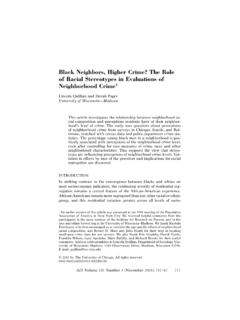Transcription of Positive Emotions in Early Life and Longevity: Findings ...
1 PERSONALITY PROCESSES AND INDIVIDUAL DIFFERENCESP ositive Emotions in Early life and Longevity: Findings from the Nun StudyDeborah D. Danner, David A. Snowdon, and Wallace V. FriesenUniversity of KentuckyHandwritten autobiographies from 180 Catholic nuns, composed when participants were a mean ageof 22 years, were scored for emotional content and related to survival during ages 75 to 95. A stronginverse association was found between Positive emotional content in these writings and risk of mortalityin late life (p <.)
2 001). As the quartile ranking of Positive emotion in Early life increased, there was astepwise decrease in risk of mortality resulting in a difference between the lowest and highestquartiles. Positive emotional content in Early - life autobiographies was strongly associated with longev-ity 6 decades later. Underlying mechanisms of balanced emotional states are may be related to a variety of factors includingheredity, gender, socioeconomic status, nutrition, social support,medical care, and personality and behavioral characteristics (Rob-ine, Vaupel, Jeune, & Allard, 1997).
3 These factors might operatethroughout life or at particular life stages. Recent Findings from theNun Study, a longitudinal study of older Catholic sisters, indicatedthat linguistic ability in Early life is associated with survival in latelife (Snowdon, Greiner, Kemper, Nanayakkara, & Mortimer,1999). In that study, the idea density (proposition, information, andcontent) of autobiographies written at a mean age of 22 years wasstrongly related to survival and longevity 6 decades later.
4 BecauseDeborah D. Danner and David A. Snowdon, Department of PreventiveMedicine and Sanders-Brown Center on Aging, College of Medicine,University of Kentucky; Wallace V. Friesen, Sanders-Brown Center onAging, College of Medicine, University of A. Snowdon is now at the Department of Neurology and theSanders-Brown Center on Aging, College of Medicine, University study was funded by National Institute on Aging GrantsR01AG09862, K04AG00553, and 5P50AG05144, and by a grant from theKleberg study would not have been possible without the spirited support ofthe members, leaders, and health care providers of the School Sisters ofNotre Dame religious congregation.
5 Archivists at each of the main con-vents were instrumental in the study. We also wish to recognize the help ofLydia Greiner in the conception of the study and Mark Desrosiers for hisvaluable scientific and programming assistance. Other staff members of theNun Study who provided invaluable assistance on this project includeDanice Creager, Gari-Anne Patzwald, Jeanne Ray, and Mary information on the Nun Study may be obtained at concerning this article should be addressed to DeborahD.
6 Danner, Sanders-Brown Center on Aging, University of Kentucky, 800 South Limestone, Lexington, Kentucky 40536-0230. Electronic mail maybe sent to autobiographies appeared to contain emotional content thatmight be associated with idea density (Snowdon et al., 1996), weinvestigated the relationship between emotional content in theseearly life writings and survival in late growing body of literature has shown Positive and negativeemotion-related attitudes and states to be associated with physicalhealth, mental health, and longevity.
7 For example, in a longitudinalstudy of Harvard graduates, Peterson (Peterson, Seligman, & Vail-lant, 1988) found the ways in which young men explained badevents predicted health outcome decades later. Such studies appearto be based on assumptions that emotion-based constructs reflectpatterns of coping with negative life events and stresses that can beharmful or beneficial to health. The assumptions of the currentlongitudinal investigation of Emotions and longevity are verysimilar and evolved from what is known about the underlyingrelationships among emotion, temperament, and physiology thatmight influence longevity.
8 This study builds on the knowledge thatthere are universal, patterned emotional responses that affect phys-iology in ways that are potentially damaging or the past 30 years, emotion researchers have identifiedbasic Emotions such as happiness, sadness, anger, fear, and disgust(Ekman & Friesen, 1969). More recently, these basic emotionshave been associated with differentially patterned autonomicnervous system (ANS) responses (Ekman, Levenson, & Friesen,1983; Levenson, Carstensen, Friesen, & Ekman, 1991; Levenson,Ekman, & Friesen, 1990; Levenson, Ekman, Heider, & Friesen,1992).
9 The functional characteristics of the associated patterns ofemotion and ANS activation (Levenson, in press) strongly suggestthe potential for a lifelong pattern of emotional arousal affectinghealth and longevity. Furthermore, numerous studies have shownthat complex emotional states, such as anxiety, produce elementsof ANS patterns associated with specific negative Emotions (Laza-rus, 1991). These same elements of elevated galvanic skin re-sponse, heart rate, and blood pressure are found in the patternedJournal of Personality and Social Psychology, 2001, Vol.
10 80, No. 5, 804-813 Copyright 2001 by the American Psychological Association, Inc. 0022-35I4/01/$ DO): Emotions IN Early LIFE805 ANS responses to the arousal of basic Emotions and potentiallycould affect health and research also has found that the suppression ofemotional states can exacerbate ANS responses (Gross & Leven-son, 1997). A lifelong pattern of suppressing the expression ofemotion has the potential for adverse effects on essential bodysystems.
















